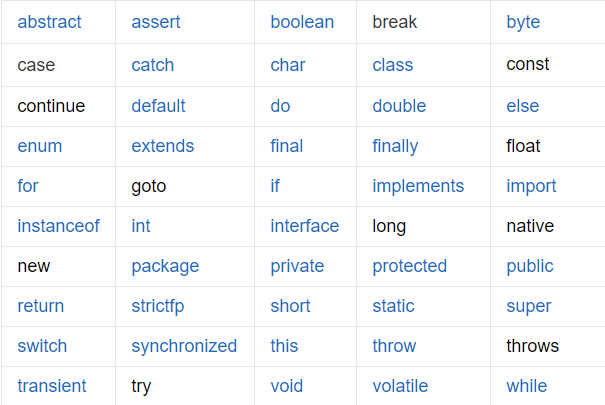1.1.HelloWorld 新建HelloWorld.java文件 編譯和運行 1.2.關鍵字和標識符 (1)所有關鍵字 (2)標識符 是指在程式中,我們自己定義的內容,比如類名,方法名和變數名等等 命名規則 可以包含英文字母、數字、下劃線和$符合 不能以數字開頭 不能是關鍵字 命名規範 類名:首 ...
1.1.HelloWorld
新建HelloWorld.java文件
// 定義一個類HelloWorld,類名必須與文件名相同 public class HelloWorld { public static void main(String[] args) { System.out.println("Hello, World!"); } }
編譯和運行
javac HelloWorld.java //編譯 java HelloWorld //運行

1.2.關鍵字和標識符
(1)所有關鍵字

(2)標識符
是指在程式中,我們自己定義的內容,比如類名,方法名和變數名等等
命名規則
- 可以包含英文字母、數字、下劃線和$符合
- 不能以數字開頭
- 不能是關鍵字
命名規範
- 類名:首字母大寫,後面每個單詞首字母大寫
- 變數名和方法名:首字母小寫,後面每個單詞首字母大寫
1.3.變數
基本數據類型
- 整數:byte short int long
- 浮點數:float double
- 字元型:char
- 布爾類型:boolean
變數的定義
public class Variable { public static void main(String[] args){ int i = 12; System.out.println(i); float f = 0.5f; System.out.println(f); char c = 'B'; System.out.println(c); } }
1.4.數據類型轉換
自動轉換
- 將取值範圍小的類型自動提升為取值範圍大的類型
- byte short char運算時直接提升為int
public class DataType { public static void main(String[] args){ int i = 5; byte b = 2; // byte類型比int小,做運算的時候會自動把byte類型轉換成int類型 int j = i + b; System.out.println(j); } }
強制轉換
- 將取值範圍大的類型,強制轉換成取值範圍小的類型
- 可能造成數據損失精度和數據丟失
public class DataType { public static void main(String[] args){ double i = 2.33; System.out.println(i); //2.33 //把double類型強制轉換成int類型 int j = (int) 2.33; System.out.println(j); //2 } }
1.5.流程式控制制語句
判斷語句
public class DemoIfElse { public static void main(String[] args){ int score = 74; if(score<0 || score>100){ System.out.println("數據錯誤"); }else if(score>=80 && score<=100){ System.out.println("優秀"); }else if(score>=60 && score<80){ System.out.println("及格"); }else{ System.out.println("不及格"); } } }
選擇語句
public class DemoSwitch { public static void main(String[] args){ int i = 2; switch(i){ case 1: System.out.println("星期一"); break; case 2: System.out.println("星期二"); break; case 3: System.out.println("星期三"); break; default: System.out.println("數據錯誤"); break; } } }
1.6.迴圈語句
public class DemoFor{ public static void main(String[] args){ //for迴圈 for(int i=1;i<=10;i++){ System.out.println(i); } //while迴圈 int j = 1; while(j<=10){ System.out.println(j); j++; } //do..while迴圈 int a = 1; do{ System.out.println(a); a++; }while(a<=10); } }
1.7.方法
package derek.day04.demo02; public class DemoMethod { public static void main(String[] args) { System.out.println(sum(2, 3)); } public static int sum(int a, int b) { int result = a + b; return result; } }
1.8.數組
package derek.day04.demo02; public class DemoArray { public static void main(String[] args) { int[] arrA = new int[] {1,2,3,4,5}; // int[] arrA = {1,2,3,4,5} int num = arrA[1]; System.out.println(num); //2 int[] arrB = new int[3]; arrB[0] = 11; //添加元素 arrB[1] = 22; arrB[2] = 33; //數組長度 System.out.println(arrB.length); //3 //數組的遍歷 for (int i = 0; i < arrB.length; i++) { System.out.println(arrB[i]); } } }


